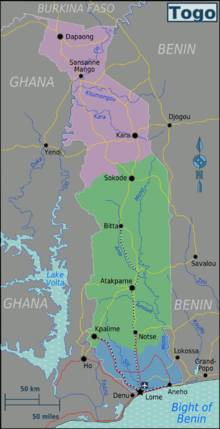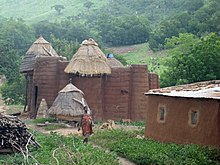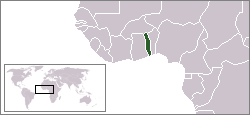Togo is a narrow country in West Africa, sandwiched between Ghana on the west and Benin on the east. Togo is a charming country, but most of the charm comes from the charming people; this is a small country with a small number of small attractions.
Regions
edit
| Maritime Togo (Lomé) the Atlantic coast and the region that the vast majority of visitors see |
| Central Togo (Atakpame) rolling hills and forests, seldom visited, comprising the administrative regions of Centrale and Plateaux |
| Northern Togo (Kara) land of the Kabye people, comprising the administrative divisions of Savanes & Kara |
Cities
edit- 1 Lomé — capital and largest city in the country
- 2 Aneho— previously known as Anecho, is a town in southeastern Togo, lying on the Gulf of Guinea near the border of Benin
- 3 Atakpamé —
- 4 Badou — is a town in western Togo near the Ghanaian border, in Plateaux Region
- 5 Dapaong — is a city in northern Togo and prefecture seat of Tône in the Savanes Region
- 6 Kara — Kara is a city in northern Togo, situated in Kara Region, 413 km north of the capital Lomé.
- 7 Kpalimé —
- 8 Sokodé — Sokodé is the second largest city in Togo, with a population of about 189,000
Other destinations
edit- 1 Koutammakou – a UNESCO world heritage site where the traditional Batammariba people live in mud tower-houses
- 2 Fazao Mafakassa National Park — the largest of three national parks, in Central Togo, near the border with Ghana
- 3 Kéran National Park — a little-visited park in Northern Togo, with little tourist infrastructure
- 4 Fosse aux Lions National Park is a national park in the Savanes Region of Northern Togo. The park is approximately 16.5 km² in size.
- Vogan - town known for its Friday market which has one of the largest voodoo markets in West Africa
Understand
editHistory
edit
In an 1884 treaty signed at Togoville, Germany declared a protectorate over a stretch of territory along the coast and gradually extended its control inland. This became the German colony of Togoland in 1905. After the German defeat during World War I in August 1914 at the hands of British troops (coming from the Gold Coast) and the French troops (coming from Dahomey), Togoland became two League of Nations mandates, administered by the United Kingdom and France. After World War II, these mandates became UN Trust Territories. The residents of British Togoland voted to join the Gold Coast as part of the new independent nation of Ghana, and French Togoland became an autonomous republic within the French Union.
Togo's size is just less than 57,000 km² (22,000 sq mi). It has a population of more than 6,600,000 people, which is dependent mainly on agriculture. The mild weather makes for good growing seasons. Togo is a tropical, sub-Saharan nation.
Togo gained its independence from France in 1960. In 1967, Gnassingbé Eyadéma, the former leader of the country, led a successful military coup, after which he became President. Eyadéma was the longest-serving leader in African history (after being president for 38 years) at the time of his death in 2005. In 2005, his son Faure Gnassingbé was elected president. About a third of the population live below the international poverty line of US$1.25 a day.
People
editIn Togo, there are about 40 different ethnic groups, the most numerous of which are the Ewe in the south (46%, although along the south coastline they account for 21% of the population), Kotokoli and Tchamba in the center, and Kabyé in the north (22%). Another classification lists the Uaci or Ouatchis (14%) as a separate ethnic group from the Ewe, which brings the proportion of Ewe down to 32%. However, there are no historic or ethnic facts that justify the separation between Ewes and Ouatchis. The term Ouatchi may refer to a subgroup of Ewes which migrated south during the 16th century from Notse the ancient Ewe Kingdom capital, although this classification has been contested for being politically biased (it would designate the Ouatchis as a subgroup of the Ewe just as the Anlo in the Republic of Ghana are a subgroup of the Ewe ethnic group). Mina, Mossi, and Aja make up roughly 8% of the population, with under 1% being European expatriates who live in Togo as diplomats and for economic reasons.
Climate
editThe climate is generally tropical with average temperatures ranging from 27°C on the coast to about 30°C in the northernmost regions, with a dry climate and characteristics of a tropical savanna. To the south there are two seasons of rain (the first between April and July and the second between October and November).
Landscape
editHighly variable stretching from north to south. Gently rolling savanna in north; central hills; southern plateau; low coastal plain with extensive lagoons and marshes.
Religion
editIndigenous beliefs 51%, Christianity 29%, Islam 20%
Tourist information
edit- Togo Tourism website
Get in
edit
Entry requirements
edit- A 7-day visa will cost you CFA 10,000-15,000 depending on your nationality at the border or Airport. A one month visa extension costs CFA 500, plus two photo ID (~CFA 1000 for 4 photos).
- A 30-day visa bought from the Togo Embassy in London costs £55.
By plane
edit
Several airlines offer regular flights to Lomé (LFW IATA). Ethiopian Airlines and Royal Air Maroc have some good return fares from Europe to Lome. You can also fly to Accra airport in Ghana then get a comfortable, air-conditioned, and reasonably priced bus from Accra to the border at Aflao. At Aflao, people must walk across the border into Lomé and find their own transport inside Togo.
By car
editThere are bush taxis everywhere. These are basically four door cars, with four people in the back, and two sharing the front. From either Accra or Benin, you can take bush taxis for US$5 to Lomé. From there, you can take them out to more rural areas. You can also offer to pay for the entire car, so that you're not cramped. For this, calculate the price of six people, and then bargain down from there.
The Trans-West African Coastal Highway crosses Togo, connecting it to Benin and Nigeria to the east, and Ghana and Côte d'Ivoire to the west. When construction in Liberia and Sierra Leone is finished, the highway will continue west to 7 other ECOWAS nations. A paved highway also connects Togo northwards to Burkina Faso and from there north-west to Mali and north-east to Niger.
By bus
editThere are overland buses from Burkina Faso, Ghana and Benin.
Get around
editA taxi-moto (motorcycle taxi) will cost CFA 150-500 to get you around. You can tell who the taxi-moto drivers are: they will honk or hiss at you as they drive by and usually wear baseball caps and sunglasses. A taxi will usually cost about CFA 500 for a one-way short trip inside the city, for trips to the northern parts of the city expect to pay up to CFA 2,500. Taxis will have yellow licence plates and their registration number painted on the car. Always negotiate before you get on/in, the quoted price will include tip.
Sometimes, when you are on a side street, it might be helpful if you ask a security guard to wave down a taxi for you. Tipping CFA 300-600 is expected.
By train
editThere is no train service in Togo.
Talk
editFrench is the national language and the lingua franca between ethnic groups. Virtually no English is spoken in the whole of the country, aside from business offices and major banks in the capital.
Ewe is far and away the most widely spoken native language, with the Ewe people populating the southern half of the country. You may also come across the related Mina language in the area around Aneho. Kabiyè is the predominant language of the north.
See
edit
Lomé's markets, both general and voodoo, are the most popular stop in the country along the road between Ghana and Benin. The smaller towns of Togoville on Lake Togo and Aneho on the ocean are also popular stops for the former's voodoo shrines and historic sights and the latter's beaches.
Lately, the coffee growing region around Kpalimé has become popular with the errant tourist in Togo, with a good number of nice hikes, cooler weather, and pleasant views.
Perhaps the most alluring part of the country is the hardest to get to—the hilly and sparsely populated north. The best known destination is Tamberma Valley—the Koutammakou UNESCO World Heritage site, to the north of Kara. The local Batammariba people (known by colonists as the Tamberma) constructed and live in unique Takienta (a.k.a. Tata) "tower-houses" of mud and straw, which arguably have become the Togolese national symbol. It's a surreal dreamland of a place, and easily a highlight of a trip to Togo, although it is a journey to get there.
Togo's few parks/reserves are relatively rarely visited, but if you manage to make it out there on a safari, Fazao Mafakassa National Park in the center-west of the country is quite beautiful. In the far north of the country is Kéran National Park, with one of the larger elephant populations in West Africa. Aside from Kéran, the north also offers a ton of potential outdoor excursions, with nice hikes up mountains, out to waterfalls, etc. Akloa falls
Do
editSports, especially football, are the main entertaining activity in Togo. You can watch the football league games played in the weekends (check listings). Apart from football, there are several night clubs that can keep you awake at night, and the capital is full of them; the Chess BSBG is among the most popular.
TV programs are not the best in the world, with films and sitcoms that have been played for years.
The beach offers another type of fun. Many activities and parties are organized there, with people coming from all over Lomé to enjoy the beautiful weather in the weekends. Despite those great things at the beach, you really have to choose a good spot to avoid stepping or sitting on the unwanted.
Buy
edit
Money
edit|
Exchange rates for CFA francs
As of January 2025:
Exchange rates fluctuate. Current rates for these and other currencies are available from XE.com |
The currency of the country is the West African CFA franc, denoted CFA (ISO currency code: XOF). It's also used by seven other West African countries. It is interchangeable at par with the Central African CFA franc (XAF), which is used by six countries. Both currencies are fixed at a rate of 1 euro = 655.957 CFA francs.
The West African CFA franc is to be renamed the "eco" by the end of 2027. It would continue to be fixed to the euro.
ATMs
editAll Ecobank and Banque Atlantique ATMs in Togo take Master card and Visa card for cash withdrawal.
Costs
editA liter of gasoline will cost you around CFA 600, a liter of water around CFA 300. A baguette is around CFA 175 and half a pound of local coffee will cost CFA 1,200. A beer in the supermarket will cost your around CFA 350, at an expat restaurant this will be around CFA 1,000. A Coca-Cola will cost you CAF 200-400 in the supermarket. "Western food", mostly imported from France, can be found in supermarkets, but is more pricey than in Europe.
Markets
editThe most popular souvenirs from Togo tend to be something voodoo related, like a charm or mask. The obvious place to shop for these curios is Lomé's voodoo market, although you will be paying tourist trap-premium prices.
Eat
edit
Akume is made from corn flour. The "national" dish of West-Africa is Fufu. In Togo, it consists of white yams pounded into a doughy consistency. You will find plenty of Fufu Restaurants in the cities as well as roadside stands. Akume and Fufu are usually eaten with your hands and come with different sauces (from smoked fish to spicy tomato to peanut).
Plantains can also be found in various forms; grilled, cooked, mashed or fried. In the season, mangos, papayas, and pineapples are for sale everywhere.
Drink
editLemonade and Bissap juice are the most popular drinks. There are many bars almost around all corners in Lomé where you will be able to have a beer.
The most popular drinks you will find in common bars are beers and sodas. Here is a list of the beers you may find based on their popularity:
- Pils
- Guinness
- Castel
- Flag
- Eku
- Lager
- Cocktail de fruit
- Coca Cola
- Fanta
- Pompom (apple based soda)
- Limonade
- Sprite
- XXL (red-bull-like soda)
- Schwepp's Tonic
- Pamplemousse (grapefruit based soda)
- Sodawater
- Moka
- Malta
- Malta Guinness
Don't be surprised if most of the bars do not have what you ask. The Togolese are not renowned for their organisation and tight management, except one small motel called "Auberge London" in the northern suburbs of Lomé called "Agoe" where you will have all the possible drink listed above.
Sleep
editWork
editStay safe
edit
As a rule, stay away from public beaches, where tourists find themselves mugged any time of day or night. Most of the country has little crime, but Lomé is a clear exception, and is a good deal more dangerous than any city in Ghana or Benin. If going somewhere at night, take a car taxi, and get the numbers of a few trusted taxi drivers if you plan to stay for a while.
Driving is atrocious in Togo, with fatalistic overloaded speed demons chancing it on curves and hills, capital streets swarming with motorcycles throughout the black of night, and worrisome accident scenes along the main roads. The hilly north-south road north of Kara is particularly dangerous. If you are skeptical, take a day trip, and marvel at all the husks of buses and trucks that weren't there on the way out! Traffic is the single biggest danger to travelers in Togo.
Stay healthy
editDrink bottled water such as Volta or sachets of "Pure Water". Bissop juice is also fairly safe as it is boiled, and avoid the lemonade "citron" despite its delicious appearance. Stay away from roadside meals if possible. People relieve themselves in the streets in Lomé, so be aware of that.
Respect
edit|
Ramadan
Ramadan is the 9th and holiest month in the Islamic calendar and lasts 29–30 days. Muslims fast every day for its duration and most restaurants will be closed until the fast breaks at dusk. Nothing (including water and cigarettes) is supposed to pass through the lips from dawn to sunset. Non-Muslims are exempt from this, but should still refrain from eating or drinking in public as this is considered very impolite. Working hours are decreased as well in the corporate world. Exact dates of Ramadan depend on local astronomical observations and may vary somewhat from country to country. Ramadan concludes with the festival of Eid al-Fitr, which may last several days, usually three in most countries.
If you're planning to travel to Togo during Ramadan, consider reading Travelling during Ramadan. |
Greetings are a little more elaborate in Togo. Say hello to everyone when coming and going. Handshakes are key. Also, maybe if you try to get to know them, you will fit in. Make sure you make yourself feel like you are at home. Don't make it too homey, though, because you don't want to get on their bad side.
Connect
editFrom some time after 2011, telephone numbers throughout Togo have changed from 7 to 8 digits. The original 7 digit numbers are no longer working in May 2013. Fixed line numbers have an additional 2, so for example, a Lomé number 2## ## ## becomes 22 ## ## ##. Togo Cellulaire, old numbers of the format 9## ## ## become 90 ## ## ##, 0## ## ## and 8## ## ## both are now 91 ## ## ## (the 0 and 8 are both replaced with 91), 7## ## ## becomes 92 ## ## ##. For Moov, numbers starting with 0, 6 or 8 this first digit is replaced by 98 (example: 6## ## ## becomes 98 ## ## ##), numbers starting with 5, 6 or 9 this first digit is replaced by 99 (example: 5## ## ## becomes 99 ## ## ##).
Lomé has Internet cafes, and they are cheap. You buy time by the hour, but most of the cafes feature very slow computers and internet connection speeds. You also have quite a lot of "wifi zones", charging from CFA 100 for an hour to CFA 2000-3000 for a month.
You can buy calling cards along the street. It is, however, much cheaper for people in the United States to call with their calling cards to a Togo cell phone. If you come from Ghana and stay close to the border, your Ghana SIM card will work perfectly, no need to buy a Togolese one.

